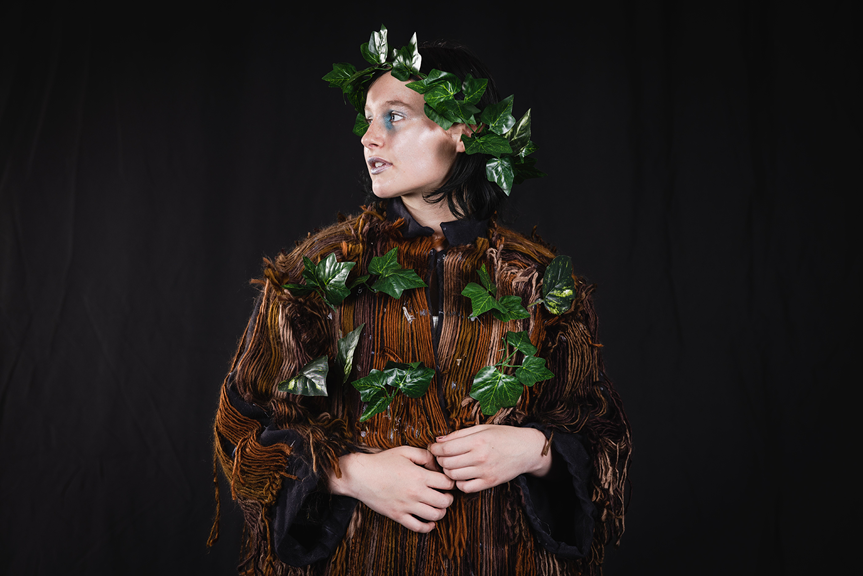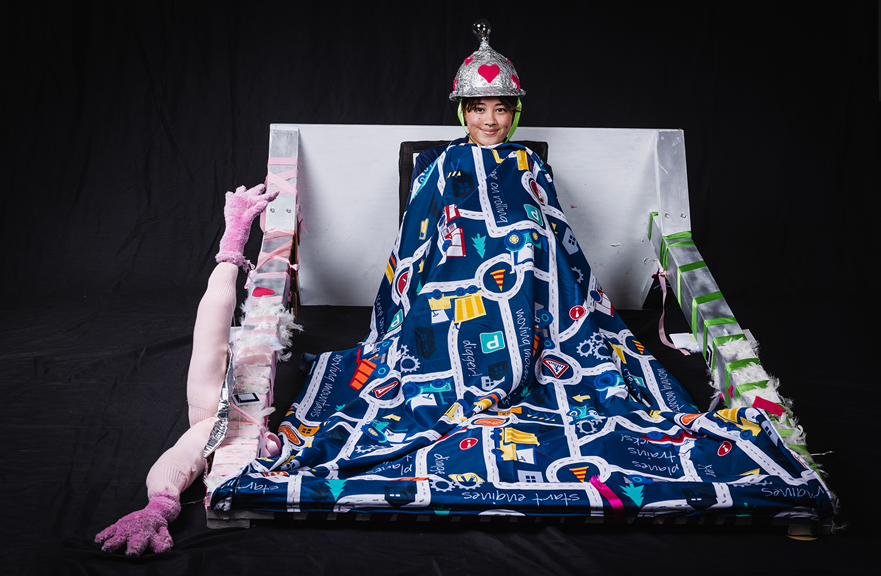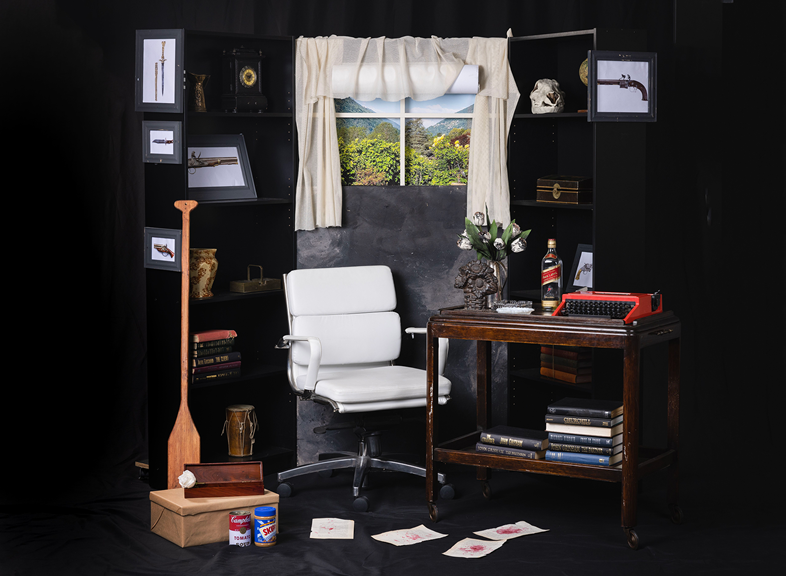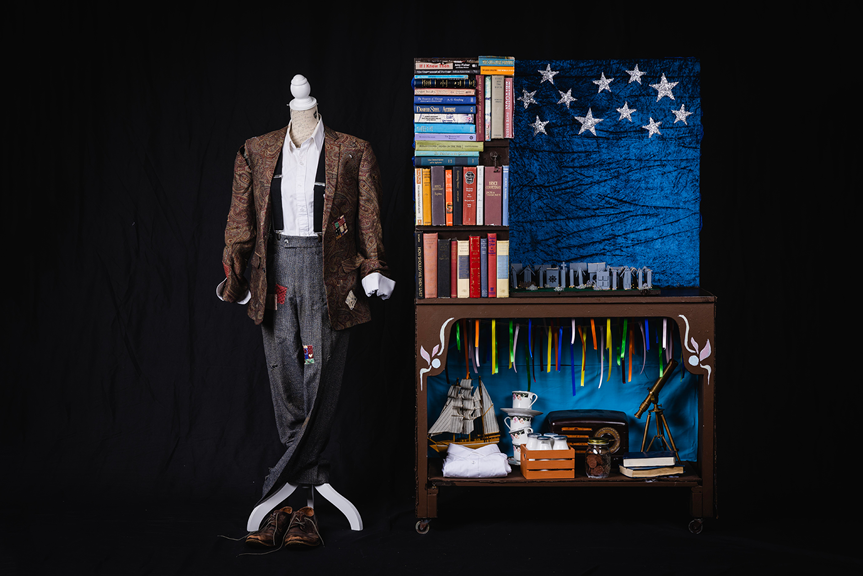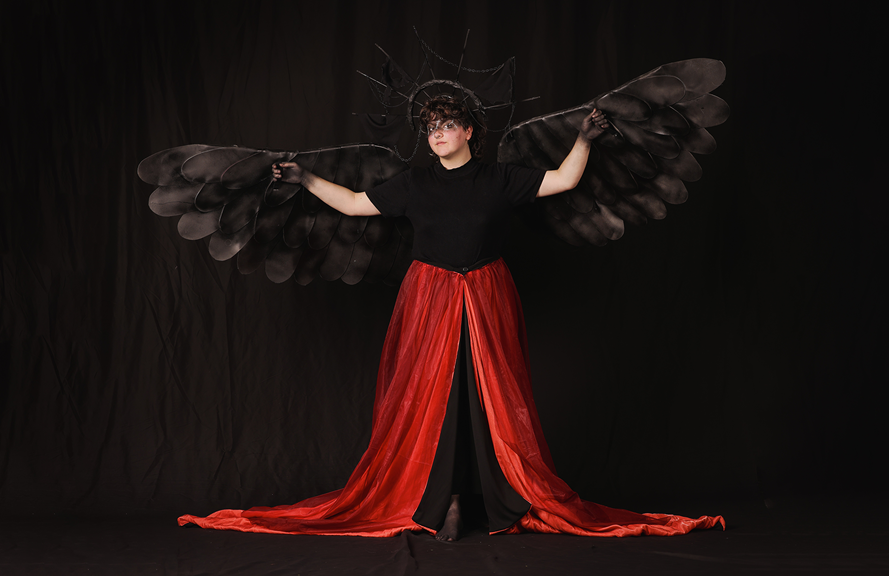
Theatre Studies
Theatre as an artform has been integral to all cultures for millennia. In VCE Theatre Studies, students gain insight into the histories and rich possibilities of theatre through interpreting and producing scripts. One aspect of VCE Theatre Studies requires students to select a monologue from a prescribed list. They explore the contexts of that script, including the time, place, culture, playwright, theatrical style, language and intended meaning.
Students interpret the selected monologue, either through acting and direction or through two areas of design. The design areas include costume, props, makeup, set, lighting and sound. A selection of student design work is showcased in Top Designs.
Outstanding students who interpret their monologue through acting and direction are featured in the VCE Season of Excellence Top Class performances.
Ella Conroy
Thornbury High School, Thornbury
Wurundjeri Country
Ariel (The Tempest, William Shakespeare)
Costume and makeup design: Mesh, beads, wool, synthetic twigs, synthetic ivy, polyester, corset, LED lights, elastic, eyeshadow
I have designed costumes and makeup for Ariel in Shakespeare’s The Tempest. As a designer, I was inspired by the influence that Ireland had on Shakespeare’s life, the colonisation of Ireland by the English, and Gaelic and pagan cultures.
My designs have been influenced by magical realism, particularly supernatural characters, Jacobean masque, dance and elaborate costume. I have also been influenced by epic theatre, particularly the political undertones of Gaelic colonial themes and gestus. My costume designs utilise the element of the theatre composition ‘emphasis’, as my wooden robe emulates the tree. Furthermore, my costume designs invoke the element of the theatre composition ‘contrast’ through the dark robe contrasting against the light ensemble underneath. My stylised, light-coloured makeup explores the element of ‘contrast’ through the white skin and black nails.
My designs are intended for an Anglo-Saxon Australian audience, urging them to reflect on the colonial discussion and think more deeply about the contemporary colonial histories of Northern Ireland and Australia.
Gemma Domingo
Caulfield Grammar School, Caufield
Bunurong Country
Man (Man Covets Bird, Finegan Kruckemeyer)
Set and costume design: Cotton sheets, wood, paint, kitchen utensils, stuffed gloves, stuffed leg warmers, safety pins, ribbon, foil, felt sheets, dictionary, wooden love heart, helmet, foil, light glove, denim coveralls, cotton pyjamas, felt
The magical-realist one-person play Man Covets Bird by Finegan Kruckemeyer is a children’s theatre work that explores notions of rebirth, growing up, belonging and the warped passing of time.
The need to make both the set pieces and costume elements transformative is the base from which l built my concepts. I explore the idea of not belonging in my costume design by putting the actor in shoes that don’t fit and oversized factory overalls, as if nothing fits him because he himself doesn’t fit in yet.
I have used the theatre composition of cohesion in my set piece design to create a balanced and whimsical aesthetic. Pairing soft tones of white and silver with three main colours – dark pink, light pink and green – I have produced a unified set piece design. Using silver details such as safety pins and clock bases, I have connected the white hues with the pink and green shades. Creating a sense of cohesion in my design helped to establish an aesthetic that intrigues the intended younger audience.
The theatre composition element of contrast has been applied to my costume design by juxtaposing dark colours against dark pink detailing. This deliberate contrast helps to personalise the ever-growing character. The hearts showcase the personality of the ‘man’ in a world filled with the ordinary.
The factory overalls and decorated hard hat have been used to foreshadow the man’s occupation. The felt squares symbolise repeated lines in the play about the ice that can form between people. The assemblage of dark pink dots create a quirky and playful atmosphere for the intended audience. I have incorporated a broken and non-functioning light bulb into the helmet design to represent the broken state of the ‘man’ who is yet to find his place in this world. In addition, I chose to adhere the light bulb with Blu Tack to establish the man’s knack for inventing objects and suggesting that his inventions can help him find his place in this world.
Olivia Gearon
Caulfield Grammar School, Caufield
Bunurong Country
Patricia Highsmith (Switzerland, Joanna Murray-Smith)
Set and prop design: Bookcase, wood, chair, paper, fabric, books, paint, metal tray, fake flowers, cardboard box, tin can, peanut butter jar, typewriter, table, chair, Scotch bottle, cup, glass ashtray, photo frames, glue
The character of Patricia Highsmith is misanthropic and bigoted and has a disturbing fascination with murder and death. My dramaturgical research has revealed that Joanna Murray-Smith’s inspiration for writing this play was to explore the ‘darkness of the human psyche‘ that exists within Patricia. This inspired me to design Patricia’s office as a metaphor for the inside of her mind. It is dark and imposing, much like Patricia’s mental state after her difficult past and years of self-imposed isolation. The office is covered in books and clutter, depicting Patricia’s affinity for literature, as well as her fascination with objects and ideas.
The set adheres to naturalist conventions, using realistic furniture and decorations. However, Switzerland also explores psychological themes, particularly the breakdown between fiction and reality. Therefore, I also chose to incorporate the non-naturalistic element of blood, which stains the books, as well as transformational theatre as the window changes.
The changing-window design symbolises the breakdown between fiction and reality through references to Patricia’s previous works, including The Talented Mr Ripley, in which an oar and a glass ashtray are used as murder weapons. In addition to this, the height difference between chairs highlights Patricia’s obsession with the power dynamic between herself and Edward.
At the beginning of the monologue, Patricia’s office appears neat and normal, but by the end of the monologue it is in complete chaos, representing the decline of Patricia’s mental health. This employs the element of theatre composition of variation, and the use of props increases the intensity as the monologue progresses. The strewn pages represent Patricia’s fictitious creations seeping into reality with the ominous manifestation of her own character.
Grace Lew-Kee
Our Lady of Mercy College, Heidelberg
Wurundjeri Country
First Voice (Under Milk Wood, Dylan Thomas)
Costume and set design: Leather dress shoes, white collared shirt, black suspenders, suit jacket, stencil, dress pants, wood, glitter, ceramic teacups, velvet, ribbon, books, cardboard, glass bottle, LED lighting, brass telescope, antique radio, playing card boxes, twine, museum board, model ship, chiffon fabric, paint
My costume and set designs respond to the First Voice monologue in Under Milk Wood by Dylan Thomas. This monologue is pivotal in introducing the small Welsh coastal town of Llareggub. My designs implement the theatrical style of magical realism to support aspects of imagination and whimsicality that inform the First Voice character.
I created a cohesive aesthetic that invites the intended adult audience to immerse themselves within the monologue and experience the imaginative world of the characters in the play. The aesthetic of my designs is playful and ties in with the play’s intended meaning to find the good in all people. The small village replica enhances the focus on the importance of community and friendship. The dark wood, hardcover books, vintage items and glittery stars create a cohesive performance space that appears mysterious and magical to engage the audience.
I have used battery-powered theatre technology to enhance the magic realist style and support the set’s transformation, enabling the book cover to transform into the library and the bookshelf to transform into the village replica. This set has been specifically designed for a single actor performing the monologue in a 5-by-5 metre space.
I wanted to show that First Voice has dedicated all of their focus to the story of Llareggub through the costume design; messily sewn scraps of fabric and mismatched buttons suggest they have mended the clothes themselves, remaining isolated and fixated on the narrative. Ultimately, the set and costume designs I have created provide a cohesive addition to the monologue from Under Milk Wood that emphasises the theatre style and enhances the actor’s ability to perform the character of First Voice in a more authentic way.
Max Vassallo La Rosa
Thornbury High School, Thornbury
Wurundjeri Country
Ariel (The Tempest, William Shakespeare)
Costume and makeup design: EVA foam, plastidip, PVC piping, PVC elbow, hat base, polystyrene balls, plastic doll eyes, gaffer tape, spray paint, headband, chain, foam, wooden dowel, wooden pegs, papier mâché, polyester, satin, jersey, soft tulle, press studs, cotton, harness straps, foil, masking tape, bolts, nuts, washer water-activated body paint, eyeshadow, charcoal powder, pencil eyeliner
My costume and makeup designs respond to the character Ariel in William Shakespeare’s The Tempest. I was inspired by the contrast between the genuine fear of magic and witchcraft under the rule of King James I, and the significant explorative and technological advancements co-occurring in the Jacobean period.
My designs are influenced by Australian Gothic, especially the unleashed conventions of the natural order and the fear of an old and unknown world. As such, I have recontextualised the location of the play to a dark, foreboding and indistinct isle.
My costume pieces exemplify elements of theatre composition including motion, emphasis and contrast. My makeup focuses on the theatre composition of emphasis. The designs have been inspired by dramaturgical research into influences on the playwright, including the shipwreck of the Sea Venture, Shakespeare’s pandering to King James I and his beliefs, and the consequences of slavery.
My designs are intended for a white Australian audience looking to understand and acknowledge the colonial history of their ancestors, whose actions are still felt strongly to this day. I utilise conventions of epic theatre to emphasise that there will always be power within the oppressed.
